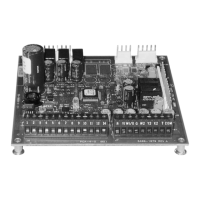RT-SVD03G-EN 119
CO
2
Sensor Connections
(ReliaTel Units with Demand Controlled Ventilation)
Demand Controlled Ventilation (DCV)
Demand Controlled Ventilation (DCV) describes a control strategy that responds to the actual
demand (need) for ventilation by regulating the rate at which the HVAC system brings outdoor air
into the building. There are several ways to assess ventilation demand:
• Occupancy sensors, which detect the presence or number of people in each monitored space.
• Occupancy schedules, which allow a building automation system to predict the current
population based on the time of day.
• Carbon dioxide (CO
2
) sensors, which monitor the concentration of CO
2
that the occupants
continuously produce.
Regardless of which method is used, DCV strategies vary the outdoor air intake in response to the
current population. The practice of using carbon dioxide concentration as an indicator of
population or ventilation rate is often called CO
2
-Based, Demand-Controlled Ventilation.
The CO
2
DCV function is only available for units with economizers; the 50% motorized damper
option will not operate with a CO
2
sensor. The 50% motorized damper opens to one position; it does
not modulate like the economizer. Also, the 50% damper does not come with a return blade or a
mixed air sensor.
The CO
2
option does not require an RTOM (3-25 tons) board.
The CO
2
sensor can be configured for 0-10 vdc, 0-20 ma, or 4-20 mA analog outputs. For use with
the ReliaTel economizer, the sensor must be set for 0-10 vdc. As the CO
2
level increases, the voltage
output increases accordingly.
The potentiometers used for setting the CO
2
setpoints and outdoor air damper position setpoints
are located on the ReliaTel RTEM module.
RTEM Operation
Units equipped with an RTEM economizer logic module will perform Demand Controlled
Ventilation differently based on the RTRM version also installed in the unit. See below for
information concerning the different configurations of RTEM and RTRM versions.
RTEM w/ RTRM v8.0 and Later
For units equipped with an RTRM v8.0 or later and also an RTEM, the control will utilize two
separate Space CO
2
Setpoints and two separate Damper Minimum Position Setpoints as described
below:
CO2 Setpoints
The CO
2
Setpoints will be obtained through two onboard potentiometers located on the RTEM;
Building Design CO
2
Setpoint (Upper Limit) and DCV Minimum CO2 Setpoint (Lower Limit). The
Upper Limit CO
2
Setpoint will have a range of 1000-2000 ppm and the Lower Limit CO
2
Setpoint
will have a range of 300-1900 ppm. A 100 ppm differential will be enforced between the Upper Limit
CO
2
Setpoint and Lower Limit CO
2
Setpoint. In the case of the Lower Limit CO
2
Setpoint being set
to compromise this 100 ppm differential, the Upper Limit CO
2
Setpoint will not be "pushed" and
the 100 ppm differential will be enforced. However, if the Upper Limit CO
2
Setpoint is set to
Table 43. CO
2
levels and associated voltage outputs.
CO
2
Level (ppm)
0 200 400 600 800 1000 1200 1400 1600 1800 2000
Voltage
Output (vdc)
01234 5 6 7 8 9 10

